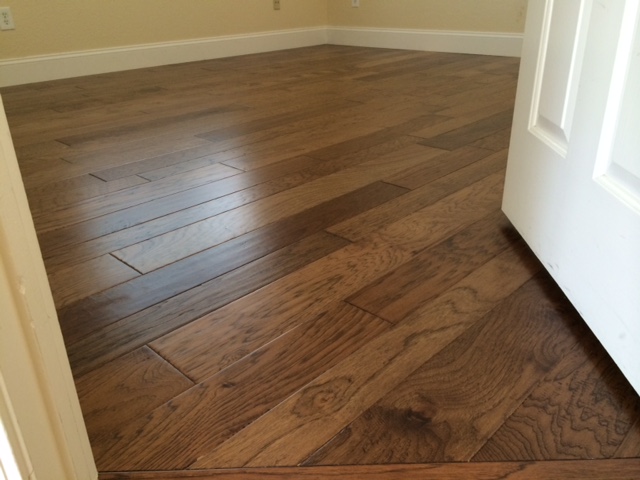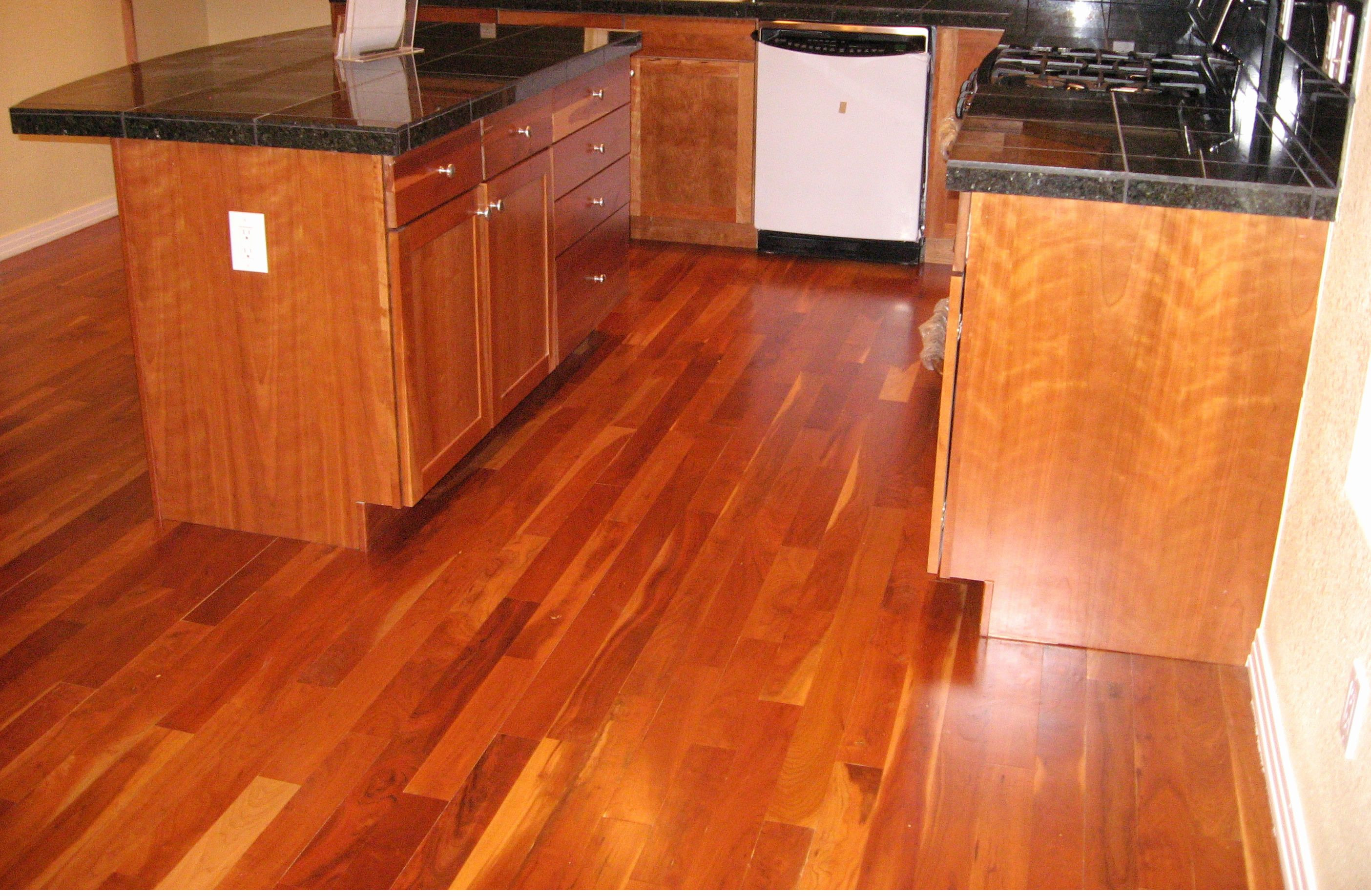Ever wondered if you could rejuvenate your engineered wood floors by sanding and refinishing them? The answer is a bit more complex than a simple yes or no. While engineered wood flooring offers durability and style, the ability to refinish it depends on several key factors. Understanding these factors is crucial to making informed decisions about maintaining your floors and maximizing their lifespan.

Image: dustlessrefinishing.com
Engineered wood flooring, unlike solid hardwood flooring, is constructed with multiple layers. The top layer, called the wear layer, is made of real hardwood veneer, while the underlying layers are made of plywood or other engineered wood products. This unique construction provides stability and resistance to warping but also presents limitations when it comes to sanding and refinishing. In this comprehensive guide, we’ll delve into the specifics of sanding and refinishing engineered wood flooring, explore the crucial factors involved, and provide you with the information you need to make informed decisions about your floors.
Understanding the Structure of Engineered Wood Flooring
To understand the refinishing possibilities of engineered wood flooring, we first need to grasp its construction. It’s like a layered cake, with each layer playing a vital role. The wear layer is the crucial element for refinishing, as it’s the visible surface that gets sanded and coated. The thickness of this layer is the key determinant of how many times you can refinish your floors.
Let’s visualize this with an example. Imagine you have engineered wood flooring with a wear layer of 1/16 of an inch. You may be able to sand and refinish it once or twice, but beyond that, you risk exposing the underlying layers, compromising the structural integrity and ruining the appearance of your floors. In contrast, engineered wood flooring with a thicker wear layer of 3/16 of an inch or more allows for multiple refinishing cycles, giving your floors a longer lifespan.
Factors Affecting Sanding and Refinishing
The feasibility of sanding and refinishing engineered wood flooring is influenced by a combination of factors:
1. Wear Layer Thickness
As discussed earlier, the thickness of the wear layer is paramount. Thicker wear layers provide more sanding room, allowing for multiple refinishing cycles throughout the life of your floors. A general rule of thumb is that you can typically refinish engineered wood flooring two to three times, depending on the wear layer thickness. However, if you’re unsure about the wear layer thickness of your flooring, consult your flooring manufacturer or a professional contractor for guidance.

Image: phenergandm.com
2. Installation Method
The installation method also plays a crucial role. If the engineered wood flooring is glued down, the sanding and refinishing process becomes a bit more complex. The glue can make sanding near the edges difficult and may require specialized techniques to avoid damaging the subfloor. Although refinishing glued-down engineered wood flooring is possible, it’s often best left to experienced professionals.
3. Flooring Finish
The type of finish applied to your engineered wood flooring impacts its refinishability. Some finishes, like urethane or polyurethane, are more durable and allow for multiple refinishing cycles. However, certain finishes, such as oil or wax-based finishes, may not be compatible with sanding and refinishing. Consult your flooring manufacturer or a professional flooring specialist to determine the suitability of your finish for refinishing.
4. Existing Damage
Any existing damage, such as scratches, dents, or water damage, can significantly affect the refinishing process. Extensive damage may require more aggressive sanding to remove, and in severe cases, it might not be possible to refinish the damaged areas. Assessing the extent of damage before refinishing is essential to setting realistic expectations and determining whether refinishing is the best solution.
The Process of Sanding and Refinishing Engineered Wood Flooring
If you decide to refinish your engineered wood flooring, the process typically involves the following steps:
1. Preparation
The first step involves preparing the space. This includes removing furniture, protecting surrounding areas, and covering vents and appliances. It’s also essential to remove any loose or damaged boards that can’t be refinished.
2. Sanding
Next, the existing finish is gradually removed with progressively finer sandpaper grits. This process involves sanding the entire floor using specialized equipment called drum sanders, edge sanders, and hand sanders. The sanding process removes the worn-out finish and evens out any minor irregularities in the flooring surface.
3. Staining (Optional)
Optional staining can be applied before the final finishing coat to change the color and enhance the look of the floor. However, staining should be done with caution on engineered wood flooring, as too much sanding can expose the core layers and lead to uneven color absorption. If you decide to stain, consult with an experienced flooring professional to avoid potential issues.
4. Refinishing
After sanding and optional staining, a new finish is applied to the floor. This involves multiple layers of sealant or polyurethane, which provide protection and enhance the appearance. The finish is typically applied with a brush or roller, allowing it to dry and cure before applying the next layer. Achieving a smooth, durable, and aesthetically pleasing finish requires careful attention to detail and proper application techniques.
Professional vs. DIY Refinishing
While some DIY enthusiasts may be tempted to tackle refinishing their engineered wood flooring themselves, it’s crucial to consider the complexity and safety involved. Refinishing flooring is a demanding task that requires specialized equipment, technical expertise, and experience to ensure optimal results.
If you lack the necessary skills and tools, it’s highly recommended to hire a professional flooring contractor for refinishing. Professionals have the expertise to assess your flooring, determine its refinishability, and handle the sanding and finishing processes with precision. They can also advise you on the best finishes and products suited to your specific flooring type and desired aesthetic.
Alternatives to Sanding and Refinishing
If sanding and refinishing aren’t feasible due to wear layer thickness limitations, damage, or other factors, consider these alternatives to rejuvenate your engineered wood flooring:
1. Screening and Refinishing
Screening involves using a special screening machine that applies a thin layer of abrasive material to the existing finish. It’s a less invasive procedure than sanding and can be used to freshen up the finish, remove light scratches, and restore a subtle sheen to your floors.
2. Recoating
Recoating involves applying a fresh layer of sealant or polyurethane on top of the existing finish. It’s a simple and cost-effective way to refresh the look and protect your floors. However, recoating may not address deeper scratches or damage, and multiple recoating cycles can build up layers of finish, making the floor feel uneven over time.
3. Floor Cleaning and Polishing
Regular cleaning and polishing can do wonders for maintaining the appearance and shine of engineered wood flooring. Use specialized cleaning products designed for hardwood floors, and avoid harsh chemicals that can damage the finish. Polishing with a floor buffer can also restore a glossy sheen and enhance the overall appearance of your floors.
Can Engineered Wood Flooring Be Sanded And Refinished
Conclusion
While you may not be able to refinish your engineered wood flooring as often as solid hardwood, it’s still possible to extend its lifespan with proper care and maintenance. Understanding the factors influencing refinishability and exploring alternatives like screening, recoating, or cleaning and polishing can help you make informed decisions about your flooring’s longevity and keep it looking beautiful for years to come. Remember, consulting with a flooring professional can provide expert advice and ensure your floors receive the appropriate care and treatment.





